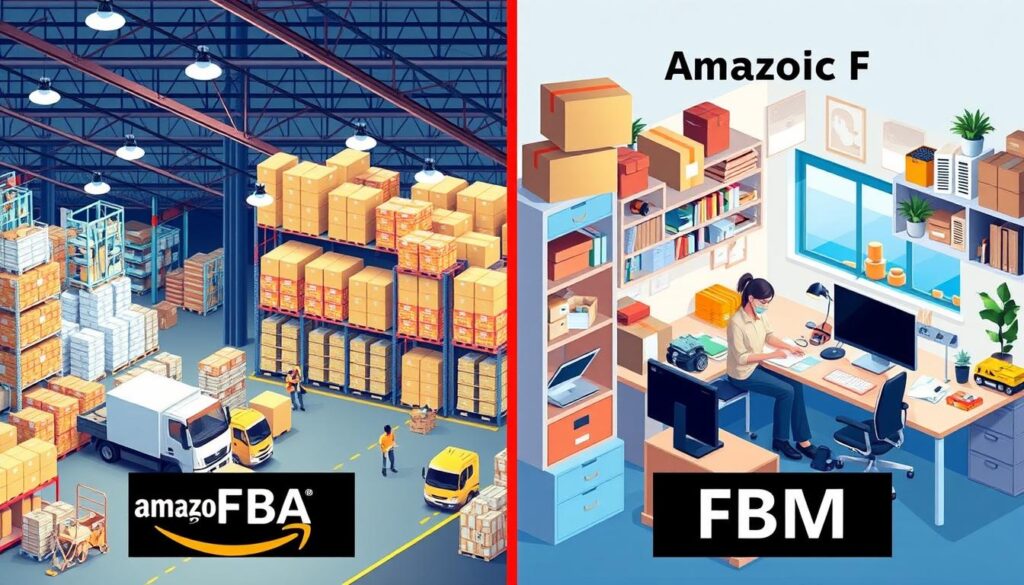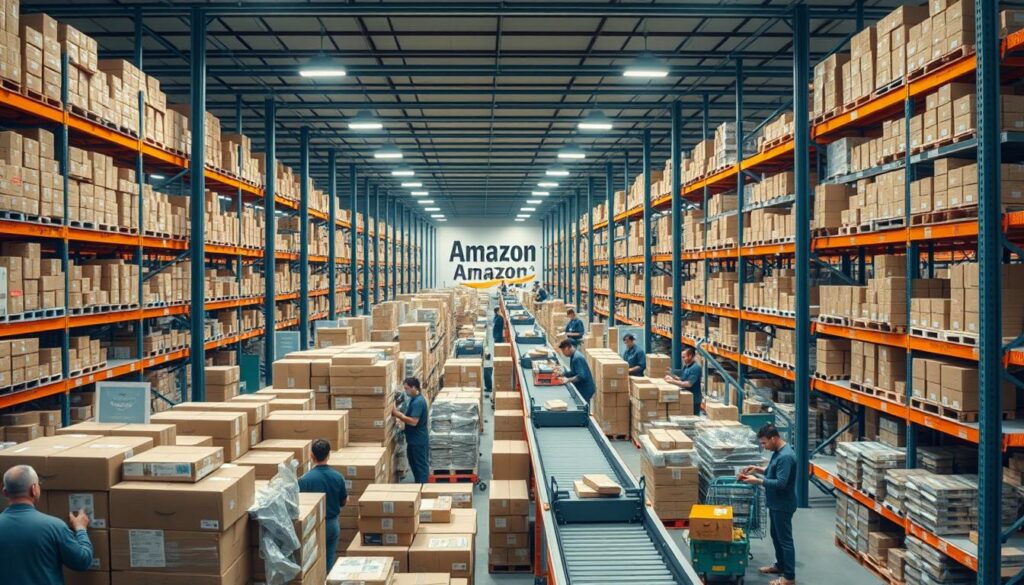Amazon is a big name in e-commerce, offering many ways for sellers to fulfill orders. Choosing between Fulfillment by Amazon (FBA) and Fulfillment by Merchant (FBM) is key to your business’s success. This article will help you understand these options and pick the best one for your online store.

Key Takeaways
- Explore the pros and cons of Amazon FBA and FBM fulfillment models
- Understand the cost implications and pricing structures for each option
- Identify the benefits and drawbacks of managing your own inventory and shipping
- Gain insights to make an informed decision on the best fulfillment strategy for your Amazon business
- Discover how to maximize your profit margins and enhance customer satisfaction
Understanding Amazon’s Fulfillment Options
When selling on Amazon, you have two main choices: Fulfillment by Amazon (FBA) and Fulfillment by Merchant (FBM). Each option has its own benefits and things to consider. Knowing the differences is key to picking the right path for your business.
What is Fulfillment by Amazon (FBA)?
Fulfillment by Amazon (FBA) means Amazon takes care of storing, packing, and shipping your products. You send your items to Amazon’s warehouses. Then, Amazon handles the Amazon fulfillment services, like order processing and customer service. This is great for sellers who focus on inventory management and want to use Amazon’s shipping methods.
What is Fulfillment by Merchant (FBM)?
Fulfillment by Merchant (FBM) lets sellers handle everything themselves. You store, pack, and ship products to customers. FBM sellers control their seller central operations but must handle customer service and returns themselves.
Key Differences Between FBA and FBM
- Inventory management: FBA sellers store products in Amazon’s warehouses, while FBM sellers manage their own storage.
- Shipping and logistics: Amazon takes care of shipping for FBA sellers, but FBM sellers handle their own.
- Customer service: FBA offers customer service support, including returns and refunds. FBM sellers handle all customer inquiries and issues.
- Fees: FBA sellers pay various fulfillment fees to Amazon, while FBM sellers avoid these fees but may have higher operational costs.
It’s important to understand the unique features of FBA and FBM. This helps you choose the best fulfillment model for your Amazon selling strategy and business needs.
Amazon FBA vs. FBM: Which Model Is Best for You?
When selling on Amazon, you have two main options: Fulfillment by Amazon (FBA) and Fulfillment by Merchant (FBM). Each has its own benefits. Your choice depends on your business size, product type, and sales volume. Let’s look at what to consider to find the best fit for your Amazon strategy.
If you have a small inventory or sell less, FBM might be better. It lets you control your inventory and shipping. This can help you save money and keep a personal touch with customers. But, without Amazon’s Prime and logistics, reaching more customers and meeting delivery times can be tough.
For bigger businesses or those with many products, FBA is often the top choice. It uses Amazon’s huge fulfillment network. This means faster shipping, more scalability, and the chance to offer Amazon Prime. It can really boost sales and customer loyalty. But, it also means higher fees and less control over logistics.
Choosing between FBA and FBM needs careful thought. You should compare your business model, seller strategy, product, and growth plans. By looking at the good and bad of each, you can pick what’s best for your business.
“The choice between FBA and FBM is not one-size-fits-all. It requires a thoughtful evaluation of your business and customer needs to determine the best path forward.”
Cost Analysis: FBA and FBM Pricing Structures
Choosing between Amazon’s Fulfillment by Amazon (FBA) and Fulfillment by Merchant (FBM) models requires knowing the costs. Let’s explore the pricing of these two options to guide your choice.
FBA Fee Breakdown
FBA comes with various fees like storage costs, fulfillment fees, and referral fees. Storage fees depend on how much and for how long you store items in Amazon’s warehouses. Fulfillment fees cover picking, packing, and shipping to customers. Referral fees are a percentage of the sale price, ranging from 8% to 15% based on the product category.
FBM Operating Expenses
With FBM, you handle shipping rates, customer service, and other costs yourself. This includes renting storage, buying packing materials, and managing order fulfillment. While you have more control, your profit margins might be lower than with FBA.
Hidden Costs to Consider
Both FBA and FBM have hidden costs that can affect your profits. FBA might see Amazon fees rise and risks of product damage or loss. FBM faces unexpected shipping delays or customer returns. Think about these factors to choose the best for your business.
| Factors | FBA | FBM |
|---|---|---|
| Storage Costs | Yes | No |
| Fulfillment Fees | Yes | No |
| Shipping Rates | No | Yes |
| Profit Margins | May be higher | May be lower |
Understanding the costs and hidden expenses of FBA and FBM helps you choose the right fulfillment model for your Amazon business.

Pros and Cons of Amazon FBA
Amazon’s Fulfillment by Amazon (FBA) service is a big deal for online sellers. It gives you access to Amazon’s huge logistics network and customer base. But, you need to think about the good and bad sides before jumping in.
One big plus of FBA is the Amazon Prime benefits. Your products get Prime shipping, which means fast and reliable delivery. This can really help your sales. Plus, Amazon’s customer service team takes care of all the order stuff, so you don’t have to.
But, FBA isn’t free. You pay for storage based on your inventory size and how long it stays there. This can get expensive, especially for big or slow-selling items. Also, FBA has rules on what you can store, which might limit your product choices.
| Pros of Amazon FBA | Cons of Amazon FBA |
|---|---|
| Access to Amazon Prime benefits Outsourced customer service and order fulfillment Increased visibility and sales potential Multi-channel fulfillment capabilities | Storage fees based on product size and duration Inventory restrictions on product types and dimensions Potential for higher overall costs compared to FBM Limited control over inventory management and customer interactions |
Choosing between Amazon FBA and Fulfillment by Merchant (FBM) depends on your business. Think about your products, business model, and future plans. Knowing the pros and cons helps you pick the best option for your business.

“The convenience of Amazon FBA is unparalleled, but it’s essential to weigh the costs and constraints to ensure it’s the right fit for your business.”
Benefits and Drawbacks of FBM Selling
The Fulfillment by Amazon (FBA) model is convenient and scalable. But, the Fulfillment by Merchant (FBM) model has its own advantages. Let’s look at the good and bad sides of FBM selling.
Control Over Inventory Management
FBM lets sellers keep inventory control. They can manage their storage and fulfillment as they see fit. This makes it easier to handle shipping logistics and adjust to demand changes.
Shipping and Customer Service Responsibilities
FBM sellers handle customer support and fulfillment. This means they pack, ship, and deal with returns. It helps build strong customer relationships and offers chances for branding opportunities.
Profit Margin Considerations
FBM sellers might see higher profit margins than FBA sellers. This is because they don’t have to pay Amazon’s fees. But, they need to invest in logistics, staff, and infrastructure for efficient operations.
| Benefits of FBM | Drawbacks of FBM |
|---|---|
| Maintain control over inventory management Personalize customer service and branding Potential for higher profit margins | Responsible for shipping logistics and fulfillment Increased investment in infrastructure and personnel Potential for higher operational costs |
Choosing between FBA and FBM depends on your business, resources, and goals. FBM is good for those wanting more control and profit. But, it means more work in inventory control, shipping logistics, and customer support.
Conclusion
Choosing between Fulfillment by Amazon (FBA) and Fulfillment by Merchant (FBM) is key for Amazon sellers. Each option has its pros and cons. Knowing these can help you pick the best one for your business.
FBA is great if you want easy shipping and access to Amazon’s big customer base. On the other hand, FBM gives you more control over your products and service. Your choice should depend on your business needs and goals.
Keep in mind, what works for you now might not later. As your business grows, you might need to change your strategy. Staying flexible and adapting can help your business thrive on Amazon.
FAQ
What is Fulfillment by Amazon (FBA)?
Fulfillment by Amazon (FBA) is a service by Amazon. Sellers send their products to Amazon’s centers. Amazon then handles storage, picking, packing, and shipping to customers.
What is Fulfillment by Merchant (FBM)?
Fulfillment by Merchant (FBM) is when sellers handle everything. They store, pack, and ship their products. Sellers also manage customer service and returns.
What are the key differences between FBA and FBM?
FBA and FBM differ in several ways. FBA lets Amazon handle tasks like shipping and customer service. With FBM, sellers do these tasks themselves.
What are the benefits of using Amazon FBA?
Using Amazon FBA offers many benefits. It gives access to Amazon Prime and helps manage inventory. It also ensures reliable shipping and customer service, making it easier to grow your business.
What are the drawbacks of using Amazon FBA?
FBA has some downsides. It includes storage fees and less control over inventory. It can also be more expensive, especially for low-priced or heavy items.
What are the advantages of using FBM?
FBM offers more control over inventory and potentially higher profits. It also lets you focus on your brand and customer experience.
What are the challenges of using FBM?
FBM comes with its own set of challenges. It requires managing shipping, customer service, and returns. It also means meeting Amazon’s standards and possibly growing slower than with FBA.
How do I decide between FBA and FBM?
Choosing between FBA and FBM depends on several factors. Consider your business size, product type, and sales volume. Think about how much control you want over the customer experience and your overall business goals.
